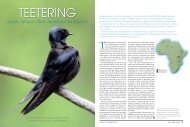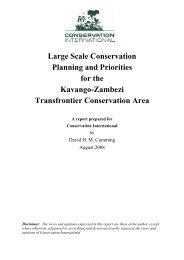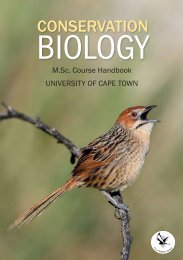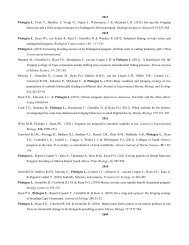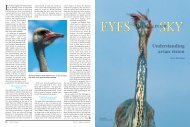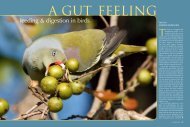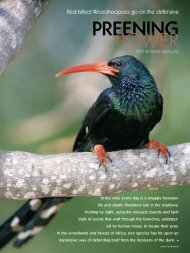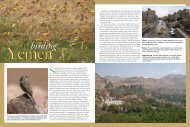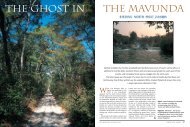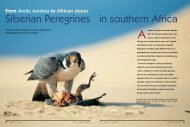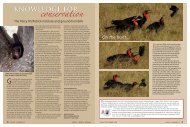Research Programmes & InitiativesAssoc. Pr<strong>of</strong>. Phil Hockeyis a member <strong>of</strong> the Board <strong>of</strong>Trustees <strong>of</strong> the SeychellesIsland Foundation. He is also amember <strong>of</strong> the Bird TaxonAdvisory Group to the Pan-<strong>African</strong> Association <strong>of</strong> ZoologicalGardens, Aquaria and BotanicalGardens, the Editorial Board <strong>of</strong>the journal BiologicalConservation, the BirdLife SouthAfrica Rarities Committee (pastChairman) and the MadagascarRare Birds Panel.Phil co-ordinates theOystercatcher ConservationProgramme, which has provedto be a well-supported and highimpact subregional project. Healso spearheads an internationalproject on bird migration. He isEditor-in-Chief <strong>of</strong> the rewrite <strong>of</strong>Roberts Birds <strong>of</strong> Southern Africaand is a co-author <strong>of</strong> the bestsellingSasol Birds <strong>of</strong> SouthernAfrica, the third edition <strong>of</strong> whichwas published in 2002. In theyear under review, hesupervised the work <strong>of</strong> two PhDstudents, four MSc students andone honours student. Heorganised and taught a modulein Community Ecology to theFitztitute’s Conservation Biologyclass and helped organise andteach an Ornithology module tothe Zoology Honours students.He authored or co-authored fivescientific papers, and refereed14 papers for eight journals.Assoc. Pr<strong>of</strong>. Phil Hockeytogether with Pr<strong>of</strong>. Morné duPlessis, also leads Lifehistory,Conservation & Rarity<strong>of</strong> Southern <strong>African</strong> BirdsResearch Programme.Ecology <strong>of</strong> MigrationProgramme leaderAssoc. Pr<strong>of</strong>. Phil HockeyResearch teamDr Richard Noskie (Northern Territories University, Australia)Dr David Bishop (Consultant, Sydney, Australia)Crab Plovers, Frigate Island, Seychelles. Earlier Fitz migration research focussed on the costsand benefits <strong>of</strong> variable-distance migration by shorebirds; focus has now shifted to theevolution and ecology <strong>of</strong> landbird migration. Photo: Phil HockeyDuring 2001-2002, we directed much effort at understanding ecological correlates <strong>of</strong>short- to medium-distance migrations among <strong>African</strong> birds. Migration patterns are,inter alia, closely linked with temperature and temperature seasonality, habitat, dietand prey capture mode. These findings are summarised in a book chapter currently inpress (Smithsonian Institution Press). This research has clearly indicated that severalso-called paradigms, stemming mostly from New World studies, do not apply in Africa.During the past year, we have “stepped back” to revisit the big picture by making interflywaycomparisons; this has not previously been attempted across all three majorflyways (Americas, Africa, Asia). We were interested primarily in how physicalgeography, patterns <strong>of</strong> habitat availability, and diet and foraging mode affectdispersion patterns <strong>of</strong> migrants on their non-breeding grounds.Locally, we have also continued studies <strong>of</strong> movement patterns <strong>of</strong> juvenile <strong>African</strong>Black Oystercatchers, having found indications <strong>of</strong> what appears to be a unique,dichotomous movement pattern.Highlights: inter-flyway comparisons• Physical geography, especially peninsula bottlenecks and barriers, stronglyinfluences migration patterns. Africa presents the fewest barriers to migration andSouth-east Asia the most (the sea crossings <strong>of</strong> Indonesia). This is mirrored in therelative prevalence <strong>of</strong> leap-frog migration across flyways (whereby those birdsbreeding the furthest north migrate the furthest south).• Among land birds, leap-frog migration is most strongly developed in thePalearctic-<strong>African</strong> system, weakly developed in the New World and absent on theEastern Palearctic-Asian flyway. A consequence <strong>of</strong> this is that while a largenumber <strong>of</strong> long-distance migrant land birds reach southern Africa, only four reachEcology <strong>of</strong> Migration 11
equivalent latitudes in Australia.• On the non-breeding grounds in central and SouthAmerica, migrants use different habitats in proportion totheir availability, and many are nectarivorous. In Africa andAsia, however, migrants strongly avoid forested habitats,and most are insectivorous. Patterns <strong>of</strong> habitat usage inAfrica and Asia are much more similar to one another thaneither is to the New World, despite that fact that Asia (likethe Neptropics) has extensive forests. Indeed, there issome suggestion that the forests <strong>of</strong> Asia may act asmigration barriers in the same way that ocean crossingsdo. Predictions about migration behaviour based solely onthe relative abundance <strong>of</strong> different habitat types wouldthus be doomed to failure.• There is evidence on at least two flyways that habitatoccupancy during the non-breeding season influencesbreeding habitat occupancy, rather than vice versa. Thisprovides some support for migration having a tropicalorigin and a demographic basis (as proposed for theNeotropics).• Overall, migratory behaviour on the two Old World flywaysis remarkably similar, despite differences in geography andhabitat; it is the New World flyway that is the “odd manout”. This strongly suggests that whatever ecologicalfactors might be maintaining migratory behaviour, theseare overlain with a strong evolutionary signal. By tackling amore detailed analysis <strong>of</strong> <strong>African</strong> migration patterns (ca1800 species), and controlling these analyses forphylogeny, we now hope to be able to assess the strength<strong>of</strong> this “signal from history”.Highlights: <strong>African</strong> Black Oystercatcher Movements• Juvenile oystercatchers from the western part <strong>of</strong> thebreeding range either remain within 150 km <strong>of</strong> their natalsite or migrate 1500-2000 km north, to one <strong>of</strong> five discrete“nursery” areas on the Namib Desert coast <strong>of</strong> central andnorthern Namibia and southern Angola. All nurseries lieoutside the adults’ breeding range. An estimated 36-46%<strong>of</strong> juveniles are migrants.• Western birds return from nurseries to their natal siteswhen they are 2-3 years old, and never migrate again. Thisstrongly suggests the existence <strong>of</strong> a “migratory gene”which, if expressed, is turned <strong>of</strong>f after 2-3 years and neverreactivated. If an analogy to this exists in any other birdanywhere in the world, we have been unable to find it(although, without doubt, it exists).• By contrast, eastern juveniles undertake “diffusiondispersal” in both westerly and easterly directions,regularly up to 1000 km. These journeys mostly end withinthe species’ breeding range; very few reach nurseries.• A genetic basis to these movement patterns could explainnot only the migratory behaviour <strong>of</strong> western birds, but alsothe intermediate behaviour <strong>of</strong> eastern birds. Western birdsaccount for ca 75% <strong>of</strong> the total population, and eastwardgenetic diffusion is thus more likely than western diffusion.• There is no evidence that movement patterns <strong>of</strong> westernbirds are linked to hatching date (we predicted that laterfledgingbirds might be “forced” to migrate by virtue <strong>of</strong> localspace being preoccupied). However, migrants aresignificantly heavier than short-distance dispersers, andwe suspect that body condition may be the trigger forexpression <strong>of</strong> a migratory gene. Interestingly, in allinstances where we have been able to follow themovement patterns <strong>of</strong> siblings, they have always behavedin the same way – either migrating or dispersing.Ringing juvenile oystercatchers. Photo: Doug Loewenthal’s collectionStudentsJane Hamblin (MSc); Dispersion patterns <strong>of</strong> Holarctic-breedingmigrant landbirds: global paradigms or regional patterns?(Degree to be awarded with distinction, Dec 2003)Kirsten Louw (PhD); Patterns and ecological correlates <strong>of</strong>migratory behaviour in <strong>African</strong> birdsDouglas Loewenthal (PhD); Population dynamics andconservation <strong>of</strong> the <strong>African</strong> Black Oystercatcher HaematopusmoquiniAcknowledgementsInternational migration studies are funded through a grantto Phil Hockey from the National Research Foundation.Oystercatcher migration research is funded by the NationalResearch Foundation, Conservation International andNamakwa Sands (through WWF).12 <strong>Percy</strong> <strong>FitzPatrick</strong> <strong>Institute</strong> Annual Report: July 2002 - June 2003
- Page 3 and 4: ContentsIntroduction 1Personnel 3Bo
- Page 5 and 6: The success of the Conservation Bio
- Page 7 and 8: Muntifering, J. BA (St Johns) Janua
- Page 9 and 10: Mission StatementTo promote and und
- Page 11 and 12: doctoral research there. To this en
- Page 13: continue to decrease unless local c
- Page 17 and 18: affinities. They have been using a
- Page 19 and 20: StudentsM.Tech. student Helen Prins
- Page 21 and 22: Islands.• Release of the National
- Page 23 and 24: conductors, where they are unlikely
- Page 25 and 26: Nature Reserve management plan and
- Page 27 and 28: PhD student Colleen Seymour is work
- Page 29 and 30: of different farming methods in the
- Page 31 and 32: the Cederberg Conservation Group at
- Page 33 and 34: iotic communities across South Afri
- Page 35 and 36: We are extremely grateful to the ma
- Page 37 and 38: on the interaction with a wide rang
- Page 39 and 40: taken over the production and maint
- Page 41 and 42: New Books: A policy of purchasing o
- Page 43 and 44: Mexico 1 (0), Morocco 1(0), Namibia
- Page 45 and 46: stressed? Journal of Thermal Biolog
- Page 47 and 48: NUNN, G.B., TARR, C.L., ROBERTSON,
- Page 49 and 50: DU PLESSIS, M.A. 2002. Masjiengewee
- Page 51 and 52: 48 Percy FitzPatrick Institute Annu
- Page 53 and 54: links among young conservation scie



